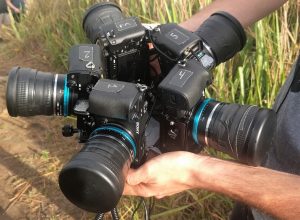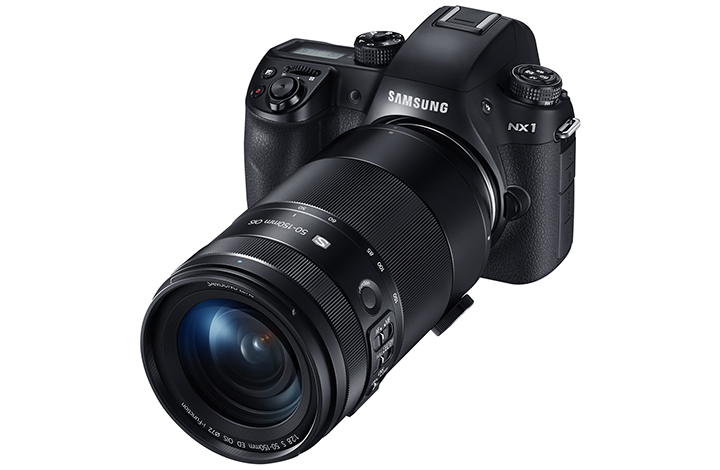I’m a long way from upgrading my multiple (from six to a dozen cameras at once!) action cameras 360 Degree Virtual Reality Rig (thus I don’t need to worry about interchangeable lens options on this rig), but when I do I am thinking to go with Blackmagic Micro Cinema Camera. Even though high resolution is very important for 360VR.
If you do go with 4K cameras then the Panasonic GH4 is a very popular 4K option (such as these guys using GH4 cameras for 360VR: http://shinichi-works.info/project_gh4.html). Also there is the Sony a7R mk2 / a7S mk2 options (but costs skyrocket, after all you’re not buying just one camera but many!) or Sony A6300 (which has overheating issues, an especially troubling issue if you have six of these operating all cramped up close together to each other! As then they’ll overheat even faster). Also Blackmagic Design has their Micro Studio Camera, but that requires an external 4K recorder, which introduces significant size/power/cost issues. Samsung NX1 is also very much worth a look (& NX500, but in 4K it has a harsh crop factor), but it is a dying system and ever since the NX1 hack came out the secondhand prices of the NX1 have been staying high.
Thus in the end I’d prefer the BlackMagic Micro Cinema Camera (BMMCC), because I’d prefer the dynamic range, bit depth, and color space of the BMMCC. And while the Panasonic GH4 / G7 does a max of 30p @ 4K, you are gaining resolution but giving up frame rate and I’d rather keep it at 60fps (as arguably high frame rates are nearly just as important for Virtual Reality as resolution is. Least you give the viewer motion sickness. And you can get higher resolution by using more cameras!). Presumably the GH5 will give 4K 60fps, but that will probably cost US$2K or more per camera (and you need many multiple ones of them of course for complete 360 degree coverage!), and it hasn’t even been announced yet so who knows.
Though given the likely length of time until I’ll be upgrading, we’ll surely see a Panasonic G7 sale by then which might make that option too cheap to resist vs going with BlackMagic Micro Cinema Cameras.
Anyway, I have still been putting a lot of thought & research this year into the various options for the future, and I decided I’d at last put the metaphorical pen to paper and share a few of my thoughts on this particular aspect of lens choices. We can broadly speaking split it into three groups:
- a) native mount (i.e. MFT lens, or E mount lenses if a person was using A6300/A7 series instead), but then this can severely limit a person a couple of years down the track if they change bodies. It would be a lot smoother / cheaper if only the bodies need to be swapped out and not lenses as well. I’d like to have some degree of versatility with this rig.
- b) full frame UWA lenses (in Nikon F mount of course, as I’ve explained in other blog posts), but not an option as you can’t then go truly wide if using them on APS-C or smaller bodies. And A7r mk2 / A7s mk2 are the only truly interesting options to consider here for use that are full frame. Maybe with the one exception of the Rokinon 14mm f2.8 lens, which does almost hit the sweet spot for price & focal length even when used on APS-C. Or the Rokinon 12mm F2.8, but then you have to deal with fisheye distortion.
- c) APS-C UWA lens, this appears to hit the sweet spot of maximum versatility plus maximum FoV.
- APS-C lens options:
- Sigma 8-16mm f/4.5-5.6, max FoV but I’d be concerned about the slow f-stop, as then you’d start to be losing one of the key gains of ditching GoPros with their poor lowlight ability.
- Tokina 11-16mm f/2.8 (or the newer Tokina 11-20mm f/2.8, but that costs more so no), this is the lens I own myself and is in my eyes the “best” UWA lens for normal filmmaking, but does that mean it is for 360VR too?? Hmm
- Rokinon 10mm f/2.8, is lighter/cheaper/wider (all 3 keys points for a 360VR rig) than the Tokina but is a fixed focal length (probably not a disadvantage though at all! As you absolutely don’t want that focal length to change once you’ve set it, thus why people will tape down zoom lenses if using them on a 360VR rig). However the Rokinon 10mm f/2.8 isn’t cheaper than Tokina when you consider the older Tokina models can easily be picked up secondhand, but the Rokinon can’t be so easily found at all secondhand as it is a newer lens.
- Rokinon 16mm f/2, the fastest option but by this point at 16mm it is only barely UWA at all.
Outside these options listed, I can’t think of any good UWA lenses, or am I missing something? Everything else that comes to mind seems that they’d all be a worse compromise somewhere in price/FoV/speed/etc than these four that I listed.
Keen to hear in the comments your views on my thought process and each of the options I reached at!

